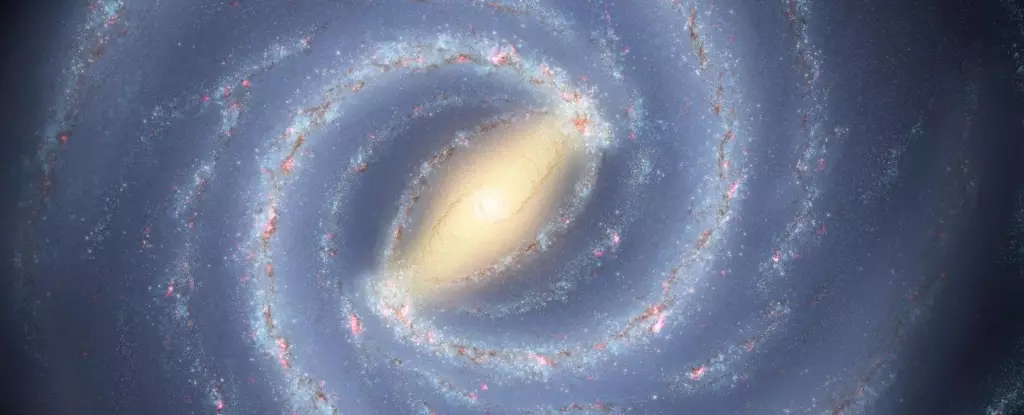The Milky Way has long served as a cornerstone for astronomers seeking to unravel the mysteries of galaxy formation and evolution. Nestled within its vast expanse, scientists are uniquely positioned to conduct detailed observations using advanced telescopes. By analyzing the Milky Way across various wavelengths, researchers gain insight into its stellar populations, gas dynamics, and other intrinsic characteristics. However, emerging studies that focus on 101 galaxies that share similar attributes to our own have illuminated significant differences, challenging the notion that our galaxy is a universal model for understanding the cosmos.
The methodology of comparative analysis—in which entities are evaluated against their counterparts—is not just a scholarly exercise but an essential component of scientific progress. Just as students learn to assess various subjects in school, astronomers leverage extensive surveys to inform their understanding of galaxies. Prominent astronomical surveys, such as the Sloan Digital Sky Survey (SDSS), the Two Micron All Sky Survey (2MASS), and the European Space Agency’s Gaia mission, have amassed large volumes of foundational data that underpin these assessments. Notably, the Satellites Around Galactic Analogs (SAGA) Survey has emerged as a vigorous tool in this pursuit, with its third data release forming the foundation for a trio of new research studies.
Central to the understanding of galaxies is the notion of dark matter haloes—massive, invisible structures that enshroud galaxies and significantly influence their formation and gravitational dynamics. Representing approximately 85% of the universe’s mass, this enigmatic matter remains largely elusive, prompting astronomers to investigate its effects through gravitational interactions. The SAGA Survey is strategically designed to probe the nature of these dark halos by investigating low-mass satellite galaxies orbiting Milky Way-like systems. Through this lens, astronomers can observe how satellites are captured and integrated into the gravitational pull of larger galaxies.
In their research, SAGA has identified hundreds of satellite galaxies encircling 101 galaxies of similar mass to the Milky Way, enhancing our understanding of the interplay between these structures. The complexity of this research is underscored by the challenges of distinguishing these faint satellites from a vast backdrop of cosmic noise. According to Risa Wechsler, a prominent figure within the SAGA Survey initiative, this ambitious endeavor required innovative techniques to uncover 378 orbiting satellite galaxies across their research focus, highlighting the meticulous effort involved in such groundbreaking studies.
The findings from the SAGA Survey indicate that the number of satellites surrounding galaxies varies significantly—from none to as many as 13 per galaxy. Notably, the most massive satellite within these systems often serves as a reliable indicator of the overall satellite abundance. For instance, about one-third of the studied galaxies host satellites comparable in mass to the Large Magellanic Cloud (LMC)—a phenomenon that may account for a greater tally of satellites relative to the Milky Way itself.
Moreover, the second segment of the research delves into star formation dynamics within these satellite galaxies. The star formation rate (SFR) acts as a critical parameter for comprehending galaxy evolution. The data reveal that although star formation continues in these satellites, proximity to their host galaxy appears to correlate with a diminished SFR. This relationship raises provocative questions regarding the influence of the dark matter halo’s gravitational forces in inhibiting star birth.
Wechsler notes, “Our results suggest that satellites within close proximity to Milky Way-like galaxies tend to experience more significant quenching of star formation.” This observation further complicates the narrative surrounding the Milky Way, suggesting that its satellite systems, which predominantly include the Large and Small Magellanic Clouds, may not conform to the more typical profile found among its analogs.
Compounding these phenomena, researchers investigate a pivotal question: What mechanisms differentiate the Milky Way’s satellite galaxy population from those of other galaxies? The unique circumstances surrounding the Milky Way—such as the distinctive mix of older, quiescent satellites and the more active Magellanic Clouds—may point to a combination of historical and environmental influences that are atypical when compared to other galaxies.
Further expansion upon these ideas leads to the third study, which juxtaposes the empirical findings of the SAGA Survey with computer simulations to model quenching processes in galaxies up to a certain mass threshold. The conclusions drawn from these ones demonstrate an encouraging alignment with observable data, though they underscore the need for additional observational research—particularly through spectroscopic surveys—to deepen our understanding of the internal dynamics within lower-mass satellite galaxies.
As we continue to bridge empirical research and theoretical models, the implications of the SAGA Survey extend not only to the Milky Way but to a broader cosmological context. According to Wechsler, “SAGA provides a benchmark to advance our understanding of the universe through the detailed study of satellite galaxies in systems beyond the Milky Way.” In this light, our efforts to decode the complexities of galaxy formation continue, revealing a universe that is as diverse as it is vast. Through comparative studies, astronomers are challenged to reconsider the Milky Way as not merely a standard but as one of many fascinating systems contributing to our understanding of cosmic evolution.

